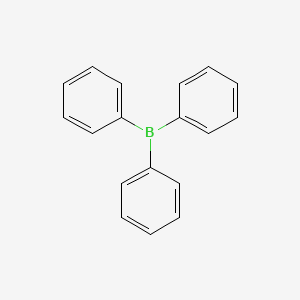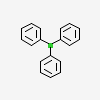Triphenylborane
- Triphenylborane
- 960-71-4
- Triphenylboron
- Borane, triphenyl-
- Triphenylborine
- Create:2005-03-26
- Modify:2025-01-18

- Triphenylborane
- 960-71-4
- Triphenylboron
- Borane, triphenyl-
- Triphenylborine
- Triphenyboron
- Borine, triphenyl
- EINECS 213-504-2
- DTXSID6027345
- AI3-60391
- UNII-6282553L0G
- BORINE, TRIPHENYL-
- DTXCID507345
- 6282553L0G
- Borine, triphenyl (6CI)
- triphenyl boron
- triphenyl-borane
- borane, triphenyl
- MFCD00003007
- CHEMBL1876579
- B(C6H5)3
- Triphenylborane, powder, <2% H2O
- Tox21_303213
- AKOS015891586
- NCGC00164184-01
- NCGC00256959-01
- AS-75476
- CAS-960-71-4
- DB-000432
- NS00007010
- G77242
- Q7843274
- 5181-80-6
2019: 1,000,000 lb - <20,000,000 lb
2018: 1,000,000 lb - <20,000,000 lb
2017: 1,000,000 lb - <20,000,000 lb
2016: 1,000,000 lb - <20,000,000 lb

P210, P240, P241, P280, and P370+P378
(The corresponding statement to each P-code can be found at the GHS Classification page.)
Aggregated GHS information provided per 44 reports by companies from 4 notifications to the ECHA C&L Inventory.
Information may vary between notifications depending on impurities, additives, and other factors. The percentage value in parenthesis indicates the notified classification ratio from companies that provide hazard codes. Only hazard codes with percentage values above 10% are shown.
Reproductive Toxin - A chemical that is toxic to the reproductive system, including defects in the progeny and injury to male or female reproductive function. Reproductive toxicity includes developmental effects. See Guidelines for Reproductive Toxicity Risk Assessment.
Dermatotoxin - Skin burns.
Patents are available for this chemical structure:
https://patentscope.wipo.int/search/en/result.jsf?inchikey=MXSVLWZRHLXFKH-UHFFFAOYSA-N
- Australian Industrial Chemicals Introduction Scheme (AICIS)Borane, triphenyl-https://services.industrialchemicals.gov.au/search-inventory/
- CAS Common ChemistryLICENSEThe data from CAS Common Chemistry is provided under a CC-BY-NC 4.0 license, unless otherwise stated.https://creativecommons.org/licenses/by-nc/4.0/Triphenylboranehttps://commonchemistry.cas.org/detail?cas_rn=960-71-4
- ChemIDplusChemIDplus Chemical Information Classificationhttps://pubchem.ncbi.nlm.nih.gov/source/ChemIDplus
- EPA Chemical Data Reporting (CDR)LICENSEThe U.S. Government retains a nonexclusive, royalty-free license to publish or reproduce these documents, or allow others to do so, for U.S. Government purposes. These documents may be freely distributed and used for non-commercial, scientific and educational purposes.https://www.epa.gov/web-policies-and-procedures/epa-disclaimers#copyrightBorane, triphenyl-https://www.epa.gov/chemical-data-reporting
- EPA Chemicals under the TSCABorane, triphenyl-https://www.epa.gov/chemicals-under-tscaEPA TSCA Classificationhttps://www.epa.gov/tsca-inventory
- EPA DSSToxTriphenylboranehttps://comptox.epa.gov/dashboard/DTXSID6027345CompTox Chemicals Dashboard Chemical Listshttps://comptox.epa.gov/dashboard/chemical-lists/
- European Chemicals Agency (ECHA)LICENSEUse of the information, documents and data from the ECHA website is subject to the terms and conditions of this Legal Notice, and subject to other binding limitations provided for under applicable law, the information, documents and data made available on the ECHA website may be reproduced, distributed and/or used, totally or in part, for non-commercial purposes provided that ECHA is acknowledged as the source: "Source: European Chemicals Agency, http://echa.europa.eu/". Such acknowledgement must be included in each copy of the material. ECHA permits and encourages organisations and individuals to create links to the ECHA website under the following cumulative conditions: Links can only be made to webpages that provide a link to the Legal Notice page.https://echa.europa.eu/web/guest/legal-noticeTriphenylborane (EC: 213-504-2)https://echa.europa.eu/information-on-chemicals/cl-inventory-database/-/discli/details/90222
- FDA Global Substance Registration System (GSRS)LICENSEUnless otherwise noted, the contents of the FDA website (www.fda.gov), both text and graphics, are not copyrighted. They are in the public domain and may be republished, reprinted and otherwise used freely by anyone without the need to obtain permission from FDA. Credit to the U.S. Food and Drug Administration as the source is appreciated but not required.https://www.fda.gov/about-fda/about-website/website-policies#linking
- New Zealand Environmental Protection Authority (EPA)LICENSEThis work is licensed under the Creative Commons Attribution-ShareAlike 4.0 International licence.https://www.epa.govt.nz/about-this-site/general-copyright-statement/
- ChEMBLLICENSEAccess to the web interface of ChEMBL is made under the EBI's Terms of Use (http://www.ebi.ac.uk/Information/termsofuse.html). The ChEMBL data is made available on a Creative Commons Attribution-Share Alike 3.0 Unported License (http://creativecommons.org/licenses/by-sa/3.0/).http://www.ebi.ac.uk/Information/termsofuse.html
- Haz-Map, Information on Hazardous Chemicals and Occupational DiseasesLICENSECopyright (c) 2022 Haz-Map(R). All rights reserved. Unless otherwise indicated, all materials from Haz-Map are copyrighted by Haz-Map(R). No part of these materials, either text or image may be used for any purpose other than for personal use. Therefore, reproduction, modification, storage in a retrieval system or retransmission, in any form or by any means, electronic, mechanical or otherwise, for reasons other than personal use, is strictly prohibited without prior written permission.https://haz-map.com/AboutTriphenylboranehttps://haz-map.com/Agents/18407
- Japan Chemical Substance Dictionary (Nikkaji)
- Nature Chemistry
- NIST Mass Spectrometry Data CenterLICENSEData covered by the Standard Reference Data Act of 1968 as amended.https://www.nist.gov/srd/public-lawBorane, triphenyl-http://www.nist.gov/srd/nist1a.cfm
- SpectraBaseBORANE, TRIPHENYL-https://spectrabase.com/spectrum/4GwzgPSBQhHBorane, triphenyl-https://spectrabase.com/spectrum/J6Hw9l259FkMXSVLWZRHLXFKH-UHFFFAOYSA-Nhttps://spectrabase.com/spectrum/8H2X885GiD5triphenylboranehttps://spectrabase.com/spectrum/A4XrRAoCgZgTRIPHENYLBORANEhttps://spectrabase.com/spectrum/KPI15jMyDsmTRIPHENYLBORANEhttps://spectrabase.com/spectrum/JAgyV2whaHXBORANE, TRIPHENYL-,https://spectrabase.com/spectrum/2Nx1KD05IntTriphenylboranehttps://spectrabase.com/spectrum/CLLoJLJ3pc3
- NMRShiftDB
- NORMAN Suspect List ExchangeLICENSEData: CC-BY 4.0; Code (hosted by ECI, LCSB): Artistic-2.0https://creativecommons.org/licenses/by/4.0/NORMAN Suspect List Exchange Classificationhttps://www.norman-network.com/nds/SLE/
- Springer Nature
- The Cambridge Structural Database
- Thieme ChemistryLICENSEThe Thieme Chemistry contribution within PubChem is provided under a CC-BY-NC-ND 4.0 license, unless otherwise stated.https://creativecommons.org/licenses/by-nc-nd/4.0/
- Wikidatatriphenylboranehttps://www.wikidata.org/wiki/Q7843274
- WikipediaWAY-100135https://en.wikipedia.org/wiki/WAY-100135Triphenylboranehttps://en.wikipedia.org/wiki/Triphenylborane
- PubChem
- GHS Classification (UNECE)GHS Classification Treehttp://www.unece.org/trans/danger/publi/ghs/ghs_welcome_e.html
- EPA Substance Registry ServicesEPA SRS List Classificationhttps://sor.epa.gov/sor_internet/registry/substreg/LandingPage.do
- MolGenieMolGenie Organic Chemistry Ontologyhttps://github.com/MolGenie/ontology/
- PATENTSCOPE (WIPO)SID 403381523https://pubchem.ncbi.nlm.nih.gov/substance/403381523
